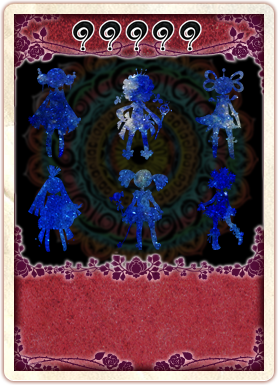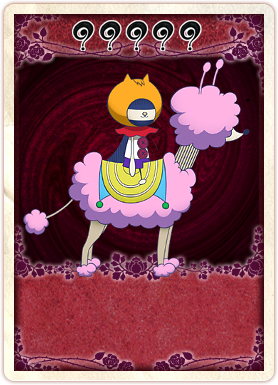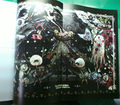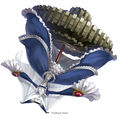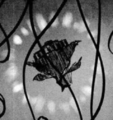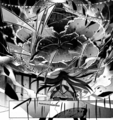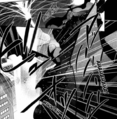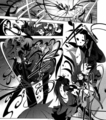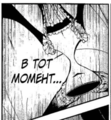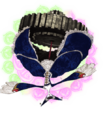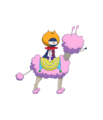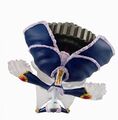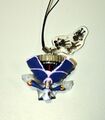Walpurgisnacht: Difference between revisions
No edit summary |
mNo edit summary |
||
| Line 152: | Line 152: | ||
File:Walpurgiscog.PNG|The gear positions itself before Madoka. It may be the true body of the witch. | File:Walpurgiscog.PNG|The gear positions itself before Madoka. It may be the true body of the witch. | ||
File:Familiar_dance.PNG|The familiars dance around Madoka before Walpurgisnacht is destroyed. | File:Familiar_dance.PNG|The familiars dance around Madoka before Walpurgisnacht is destroyed. | ||
</gallery> | |||
====The Rebellion Story==== | |||
<gallery> | |||
File:Ep1148432.jpg|Walpurgisnacht's parade elephant familiar makes a brief appearance pulling the carriage [[Sayaka]] and [[Nagisa]] are in in [[The Rebellion Story]] | |||
</gallery> | </gallery> | ||
Revision as of 08:18, 13 November 2020
She will turn all of fate's misfortune to nothing.
She will flood the earth with magic,
and take all of humankind into her play.
A moving stage construction.
If everything is a play, no unhappy things will exist.
It may be a tragedy, but it'll all be part of the script.
The play stops on Walpurgisnacht,
and the earth does not turn even once more.
The story will not change.
Tomorrow, and the day after, is the night of Walpurgis.- From the Production Note
Walpurgisnacht (ワルプルギスの夜 Warupurugisu no Yoru, "Night of Walpurgis" or "Walpurgis' Night") is supposedly the strongest witch current magical girls would have to fight. Her real name is unknown, while "Walpurgisnacht" is a common moniker given to it by magical girls. Her nature had been kept mysterious during most of the series, which led to a lot of speculation from fans during the original broadcast. This article's first purpose is, as with the other witches, to provide information about her.
The witch first appeared in the prologue "dream" sequence of Episode 1, although it wasn't called by any name back then. This led to some speculations about the witch's identity before it was finally revealed in Episode 10.
For a compilation of historical, mythological, and literary information concerning Walpurgisnacht, a term first mentioned by Homura in Episode 6, see Speculah:Walpurgisnacht.
Witch Cards
The stage-constructing witch (alias: Walpurgisnacht / real name: unknown); her nature is helplessness. She symbolizes the fool who continuously spins in circles. The witch's mysteries have been handed down through the course of history; her appellation is "Walpurgisnacht." She will continue to rotate aimlessly throughout the world until she completely changes the whole of this age into a drama. When the doll's usual upside-down position reaches the top part of the witch, she completely roils the civilization on the ground in a flash through her gale-like flight. | |||||||||||
Minions
The stage-constructing witch's minions. Their duty is to be clowns. Countless souls drawn to her vast magical power. Nobody knows whether Walpurgisnacht was initially a single person, or if it was a phantom born from the gathering of many spirits. | |||||||||||
Minions of the witch of stage constructions. (Bluenose) Witch minions that appear alongside catastrophes brought about by the giant witch known as “Walpurgisnacht”. They pull the ropes connected to Walpurgisnacht’s neck as she floats in the sky, forming a circus troupe and conducting a parade. All the members of the troupe are thought to be Walpurgisnacht’s minions, but many facts of the matter are still unclear. Some documents refer to the ones riding four-legged beasts as “Bluenose,” and the red-and-black creatures with long ears as “Rednose”. Unlike the aggressive, shadow-like minions that appear at the same time, these minions will not attack unless you obstruct their parade. Rather than attempting to fight them, it’d be much more advisable to flee as fast as possible. | |||||||||
Observations
- Kyoko Sakura confirmed that Walpurgisnacht was the most powerful witch in Episode 9; in Episode 10, however, Madoka Kaname eclipsed her in power in two of the timelines created by Homura Akemi, becoming the god-like Kriemhild Gretchen. Episode 11 showed that Walpurgisnacht can withstand repeated attacks from heavy artillery, and her mere appearance can cause hundreds of deaths.
- While Walpurgisnacht does not need to hide in a barrier, like other witches, her arrival in Mitakihara Town is preceded by a carnival-like procession of familiars. This is apparently a reflection of her theatrical theme, and possibly also evidence of her desire to transform the world into a giant "stage."
- The witch's most prominent familiars take the form of former magical girls, as evidenced by their resemblance to the magical girls shown in the final scene of Episode 12.
- The manga version even takes this one step further by explicitly featuring the deceased Sayaka, Kyouko and Mami, all of which are main characters, as Walpurgis's minions. It turns out that this depiction was in the original storyboard of Episode 11. It is unknown why this was changed.
- They also bear similiarity to characters from the music video of Maaya Sakamoto's Universe. This is unsurprising as both the MV and witch sequences are designed by animators Gekidan Inu Curry.
- Walpurgis never drops a Grief Seed in any of the timelines. Whether this is because she doesn't have one or because the Grief Seed is always lost in the confusion of battle is unknown.
- However, Walpurgis is known to have a Grief Seed in the PSP game.
- The mandala surrounding the witch has a tomoe pattern on it.
Trivia
- Official description from July 2011 Megami interview with Urobuchi: In the last episode we saw the "Walpurgisnacht", but what kind of witch is it specifically?
It has the destructive power to bring about natural disasters powerful enough to blow away an entire town, but originally it was a single witch. It's a witch that has grown from the combination of countless other witches. Walpurgisnacht combines with other witches in the same way two powerful tornadoes are able to combine and become larger. It's essentially a "conglomeration"-type witch. Because it's so powerful, it rarely shows itself. - Walpurgisnacht is named for Walpurgisnacht, a traditional spring festival celebrated on 30 April or 1 May in large parts of Central and Northern Europe. For more information on the festival's history, cultural and literary impacts, and connection to witchcraft, see Speculah:Walpurgis Night.
- The Guidebook describing the Witch's labyrinth design contains the line, "Everything in this world is fake. My life is nothing more than a drama that you penned. Please, prove it. "Faust" is on show." (この世界はすべて嘘でした。私の人生はあなたの書いた戯曲にすぎません。それを証明して下さい。「ファウスト」が上演中)
- The exterior view of Homura's residence resembles a scene from Shadow of Memories (Shadow of Destiny for North America). Interestingly, it went through several title changes before release, among them The Day and Night of Walpurgisnacht, Days of Walpurgis, and Time Adventure.
- According to witch animator and designer InuCurry, Walpurgisnacht's and Kriemhild Gretchen's silhouettes are supposed to make a pair.
- Puella Magi Production Note further reveals that Walpurgisnacht is meant to look like the upper half of a sand timer, while Kriemhild Gretchen looks like the lower half. Interestingly, Homura's shield has also been described as a sand timer.
- According to Walpurgisnacht's page in the Guidebook, the top part of the gear can turn into a stage where her familiars hold performances.
- Also according to the Guidebook, the familiars become as heavy as rocks when grabbed, like a Konaki-jiji.
- Walpurgisnacht was voiced by Kaori Mizuhashi.
- Puella Magi Madoka Magica: The Different Story mentions Walpurgisnacht as a colossal super-dreadful witch, whose existence is only known through rumors from other magical girls.
- In the german version Walpurgisnacht is just called Walpurgis.
- In art from the Puella Magi Production Note by Inu Curry, the text reads: "It tries to get rid of the all fates of misery. By covering all around the world with her magic. A moving stage set. Which trying to take all humans into the play. There is no need to grieve if all of it is just a play. Maybe it would be a tragedy, but they only performed a such kind of play. Play will be paused in Walpurgisnacht. The Earth will no longer rotate for a single circle. The story will no longer to be developed. Tomorrow and the day after tomorrow also, is Walpurgisnacht."
Gallery
Official Art
Art of Walpurgisnacht from the Puella Magi Production Note
Art featuring Walpurgisnacht and her familiars from the Key Animation Note volume 6
Art of Walpurgisnacht by Gekidan Inu Curry's Doro Inu from the Rakugaki Note
Art featuring Walpurgisnacht by Gekidan Inu Curry's S from the Rakugaki Note
Screenshots
Episode 1
Episode 8
A silhouette of an upside-down Walpurgisnacht is accompanied by the text "Ein Narr," which translates to "a fool" in German; the witch's informational card also refers to her as a "fool." However, the torn part of the image shows a part of a letter which might be part of another word, k ("kein narr" translates to "no fool"), or R ("Rein narr" means "pure fool").
Episode 10
Episode 11
- Staredown.PNG
Unaffected by previous attacks, Walpurgisnacht taunts Homura.
Episode 12
The Rebellion Story
Walpurgisnacht's parade elephant familiar makes a brief appearance pulling the carriage Sayaka and Nagisa are in in The Rebellion Story
Manga
Walpurgisnacht's first appearance in the manga
Walpurgisnacht's cameo in the Rebellion Manga
Walpurgisnacht and other witches in Puella Magi Oriko Magica: Extra Story
Walpurgisnacht in Puella Magi Oriko Magica: Sadness Prayer
Madoka Magica Portable
Bluenose from Madoka Magica Portable
Walpurgisnacht's barrier. It resembles the area Madoka runs through from Episode 1
- Portable rednose bio.jpg
Rednose's profile
Magia Record
Merchandise
'Walpurgis' Clothes' and 'Walpurgis' Hat', special bonuses from the extension set for Madoka Magica Online
See also
- Concept for Walpurgisnacht, Episode 10 version
- Glossary#Walpurgis Night: Definition from the official website

